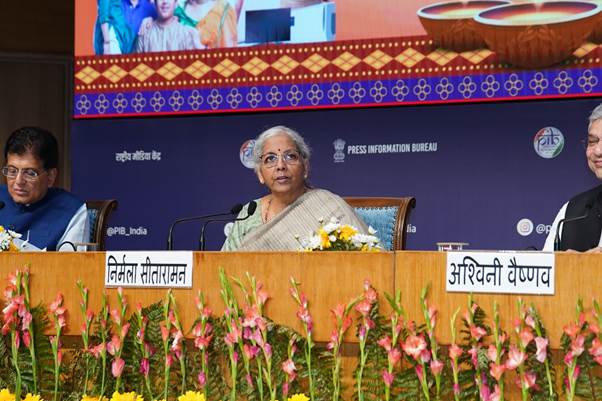Finance Minister Nirmala Sitharaman on Saturday said the benefits of the revised GST rates are fully reaching end consumers, with close monitoring of 54 select products showing positive results during the transition to next-generation reforms.
Addressing a joint press conference on GST Bachat Utsav here along with Commerce and Industry Minister Piyush Goyal and Railways, Information & Broadcasting, Electronics & Information Technology Minister Ashwini Vaishnaw, Sitharaman noted that Prime Minister Narendra Modi had announced these reforms from the Red Fort, promising implementation before Diwali.
The reforms, including rate reductions, process simplification, reduction of slabs from four to two, and resolution of classification issues, came into effect from the first day of Navratri on September 22, she said, adding that they have been well-received by the people.
“We set the course for GST and implemented it. The Opposition neither brought GST nor even dared to attempt it. What we are doing today is not a correction but a conscious decision, reflecting cooperation between the Central Government and the GST Council to pass on greater benefits to the people,” Sitharaman said.
She emphasised that tax rate reductions are aimed at benefiting consumers, in line with PM Modi’s guidance, and have been consistently pursued since 2017. The Finance Ministry’s Department of Revenue has been actively tracking prices of the 54 products to ensure the reforms’ advantages are passed on, with full compliance observed so far.
Goyal described the reforms as a “double dhamaka” of relief and prosperity for households, terming them the biggest since Independence and impacting 140 crore Indians. He thanked Modi and Sitharaman for launching the next-generation GST during Navratri, injecting excitement across households, industry and commerce.
The minister highlighted unprecedented relief of Rs 2.5 lakh crore through direct and indirect tax measures, including major income tax changes announced on February 1 to encourage savings and boost disposable income. Under PM Modi’s guidance, comprehensive tax reforms had been in the works for over a year, culminating in the September 3 announcement.
Goyal pointed to the multiplier effects already visible in investments, business and consumer spending, noting historic auto sales during Navratri, with companies like Maruti, Mahindra and Tata setting new benchmarks. He also mentioned slashed taxes on health, insurance and essential goods to enhance affordability, combined with infrastructure push, accelerating India’s growth as the world’s fastest-growing large economy.
Vaishnaw underscored the electronics sector’s record sales with a 20-25 per cent rise over last year, driven by GST reforms. Major retail chains reported unprecedented demand for televisions, washing machines, smartphones and air conditioners, with 85-inch TVs selling out and many families upgrading appliances amid rising confidence.
The reforms have stabilised the economy, particularly for middle-class households, with food inflation showing a deflationary trend of around 2 per cent over four months, he said. This has spurred double-digit growth in electronics manufacturing, creating over 25 lakh jobs nationwide.
India has overtaken its neighbour in smartphone exports to the US, with a major global firm now producing 20 per cent of its output here, Vaishnaw added. He announced production starting at two semiconductor facilities—CG Semi and Kaynes—marking a milestone in self-reliance.
Citing macroeconomic data, Vaishnaw said India’s GDP of Rs 335 lakh crore last year included Rs 202 lakh crore from consumption and Rs 98 lakh crore from investment. GST reforms have boosted consumption by nearly 10 per cent this year, adding Rs 20 lakh crore in spending and expected to drive further investments.










